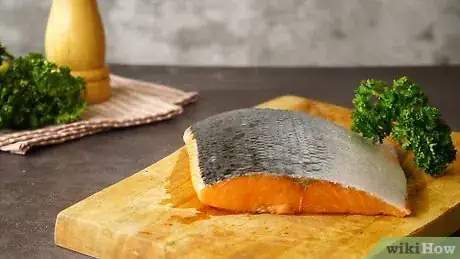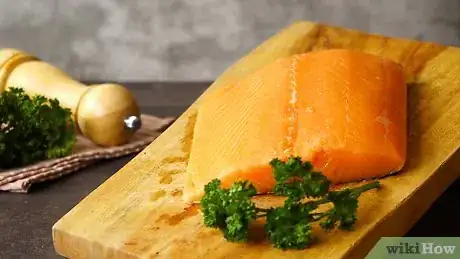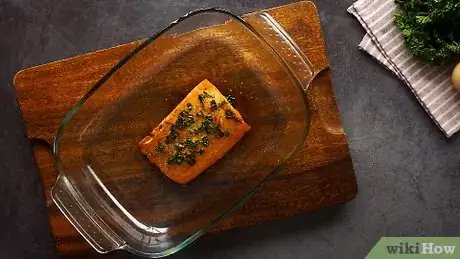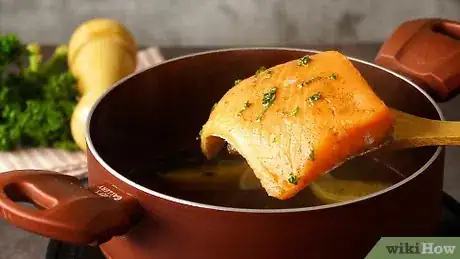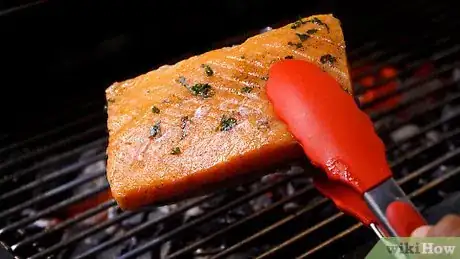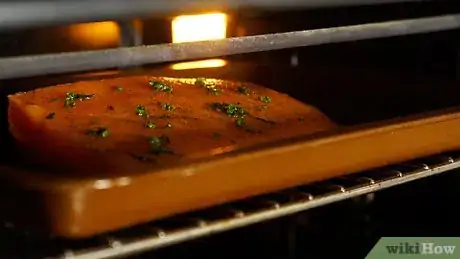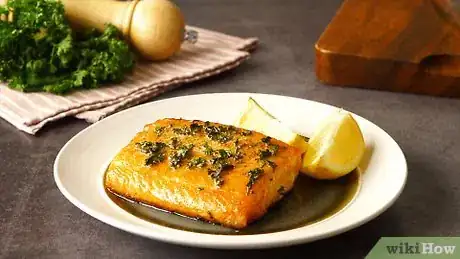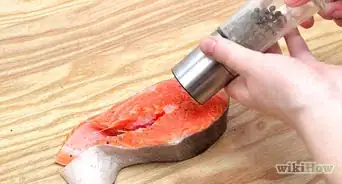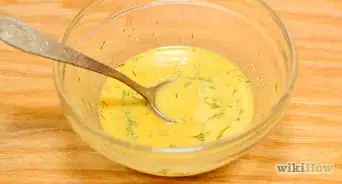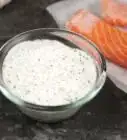This article was co-authored by Marrow Private Chefs. Marrow Private Chefs are based in Santa Rosa Beach, Florida. It is a chefs’ collaborative comprised of an ever-growing number of chefs and culinary professionals. Though regionally influenced primarily by coastal, traditional southern, cajun, and creole styles and flavors, the chefs at Marrow have a solid background in all types of cuisine with over 75 years of combined cooking experience.
wikiHow marks an article as reader-approved once it receives enough positive feedback. In this case, several readers have written to tell us that this article was helpful to them, earning it our reader-approved status.
This article has been viewed 333,211 times.
While salmon is a great choice for a meal because of its delicious flavor, it's also a great because preparing and cooking it is pretty easy! Salmon is a popular food because of its incredible nutritional profile, which is low in calories and fat and high in Omega-3 fatty acids, which are important for the immune and circulatory systems. Making a delicious, nutritious meal out of salmon typically requires some standard preparation, but you can really use your imagination when seasoning and cooking since the fish can be made into so many different tasty ways, like pan-frying, baking, or grilling.
Steps
Preparing Salmon
-
1Buy high quality salmon. Salmon purchased at a grocery store or fish market should still have the skin on to maintain its freshness and moisture. Try to buy a whole salmon side, or a fillet that is cut from the thickest part of the fish. Request a center cut piece of salmon. Purchase 6 oz. of salmon (170 grams) per person.
- Avoid salmon with a strong fishy odor. Look for moist, clean cut fillets.
-
2Know about the different kinds of salmon. There are several different kinds of salmon, all of which can be cooked in the different ways listed in the second section of this article (Cooking Salmon.)[1]
- King Salmon (a.k.a. Chinook) is known for its buttery flavor and texture. It is the largest salmon species and has the highest Omega-3 and oil concentrations of any salmon. It is generally the most expensive salmon you can buy.
- Sockeye Salmon, or Red Salmon, is more abundant than King Salmon. It has a bright red-orange color and a very rich flavor. It has a high fat and Omega-3 content. Sockeye is the most common salmon you will find in your local grocery store.
- Coho Salmon usually appears in grocery stores around August and September. It has a milder flavor that King and Sockeye salmon, and is sometimes referred to as silver salmon.
- Chum Salmon is most often used for canned salmon. It varies greatly in quality and is generally lower in oil than other types of salmon.
- Pink Humpback Salmon is the most abundant salmon of the species. This salmon is generally canned or smoked. It has a mild flavor and lighter colored flesh. Note that smoked salmon is cured with smoke and often eaten without cooking.
Advertisement -
3Decide whether you want wild versus farmed salmon. There has been controversy about the effects farmed salmon have had on the environment. Specifically, activists have alleged that farmed salmon have escaped and carried diseases to wild salmon. Proponents of wild salmon also point out that salmon in the wild have healthier diets than farmed salmon, so the meat is better tasting and looking. Talk to your local fishmonger or experts in your market about the pros and cons of wild and farmed salmon.
- Wild salmon will also look pinker and brighter than farmed varieties. Some salmon farmers inject dye into their farmed fish to make them look as pink as the wild salmon.
- It has been reported that wild salmon contains more nutrients per serving than farmed salmon, and several studies have been cited showing that farmed salmon contains more polychlorinated biphenyls (PCBs) than wild salmon.[2]
-
4Remove the skin from the salmon, if you prefer to cook it skinless. Some people prefer to keep the skin on the fish when cooking and eating it.
- Place the fillet on a cutting board with the skin side down. Sprinkle one end of the salmon with salt to make the fish less slippery. Hold the salted end of the fish and use a sharp knife to cut between the flesh and the skin slowly, until the fish pulls away from the skin.
- Discard the skin or, save it to use in other recipes. Some people enjoy making crispy salmon skin for salads or sushi.
-
5Remove the bones from the salmon, if there are any. Pull the bones out of the fish one by one in the direction of the fish's grain. Use your fingers to remove the bones.
-
6Season the salmon. Sprinkle salt and pepper on both sides of the salmon. Depending on taste, add other herbs such as parsley, dill, tarragon, and garlic. Coat the salmon with olive oil or white wine, and add any other flavors you like, including brown sugar, lemon or butter.
Cooking Salmon
-
1Select a favorite cooking method for your fish. Salmon should be cooked until the meat is opaque and flakes off easily.
-
2Poach the salmon. Poaching is a simple way to prepare salmon. The fish comes out light and fresh tasting. When poaching salmon, make sure to not overcook the fish.[3]
- Place the liquid, such as water, wine or fish stock, that you wish to poach the salmon in, into a large pan or skillet. You can also add other flavoring ingredients such as carrots, lemon, parsley, etc. Follow your specific recipe for the ingredients you should use.
- Bring the liquid to a boil and then reduce it to a simmer. Cover the pan and simmer the liquid for 8 minutes.
- Place the fish into the simmering liquid. The liquid should just cover the fish. Cook the salmon until it is opaque all the way through (about 5 minutes of simmering.)
- Remove the salmon from the liquid using a large slotted spatula.
-
3Grill the salmon. Slowly grilling salmon is one of the best ways to bring out all of the flavors of the fish. To increase the flavor, you can marinate the salmon in your favorite marinade.[4]
- Rub some oil the fish to prevent it from sticking to the grill. You may also consider greasing the grill to keep the fish from sticking.
- If you are using a charcoal grill, place the salmon on the grill rack over medium coals. Grill uncovered for 4 to 6 minutes per each ½ inch of thickness or until the fish begins to flake when cut into with a fork. Flip the fish halfway through grilling to cook it evenly.
- If you are using a gas stove, preheat the grill to a medium heat. Place the salmon on the grill and close the grill. Again, grill the fish for 4 to 6 minutes per each ½ inch of thickness. Flip the fish halfway through grilling.
-
4Bake the salmon. Baked salmon can be buttery and delicious if cooked right. Baking is also one of the easiest and least time consuming way to prepare salmon.[5]
- Place the dressed salmon in a baking dish and cook it at 350 degrees Fahrenheit (177 degrees Celsius). If you are baking salmon fillets, cook it at 450 degrees F (232 degrees C). Cook until the fish is fully opaque and flaky.
- Some recipes recommend wrapping the salmon in foil with a variety of spices, seasonings, and vegetables for moist, flavorful fish.
-
5Broil the salmon. Broiled salmon is crispier than most other prepared salmon dishes. It is particularly good to broil salmon if you like crispy skin on your fish.
- For a crispier texture, place the salmon on a baking sheet with oil and stick it under the broiler for 1 or 2 minutes.
-
6Finished.
Expert Q&A
-
QuestionIs salmon good for smoking?
 Marrow Private ChefsMarrow Private Chefs are based in Santa Rosa Beach, Florida. It is a chefs’ collaborative comprised of an ever-growing number of chefs and culinary professionals. Though regionally influenced primarily by coastal, traditional southern, cajun, and creole styles and flavors, the chefs at Marrow have a solid background in all types of cuisine with over 75 years of combined cooking experience.
Marrow Private ChefsMarrow Private Chefs are based in Santa Rosa Beach, Florida. It is a chefs’ collaborative comprised of an ever-growing number of chefs and culinary professionals. Though regionally influenced primarily by coastal, traditional southern, cajun, and creole styles and flavors, the chefs at Marrow have a solid background in all types of cuisine with over 75 years of combined cooking experience.
Private Chefs Absolutely! Salmon is a very fatty and oily fish, so it lends itself well to being smoked. Smoking accents the flavor wonderfully and also creates a texture most people find quite desirable.
Absolutely! Salmon is a very fatty and oily fish, so it lends itself well to being smoked. Smoking accents the flavor wonderfully and also creates a texture most people find quite desirable. -
QuestionIs it okay to boil fish?
 Marrow Private ChefsMarrow Private Chefs are based in Santa Rosa Beach, Florida. It is a chefs’ collaborative comprised of an ever-growing number of chefs and culinary professionals. Though regionally influenced primarily by coastal, traditional southern, cajun, and creole styles and flavors, the chefs at Marrow have a solid background in all types of cuisine with over 75 years of combined cooking experience.
Marrow Private ChefsMarrow Private Chefs are based in Santa Rosa Beach, Florida. It is a chefs’ collaborative comprised of an ever-growing number of chefs and culinary professionals. Though regionally influenced primarily by coastal, traditional southern, cajun, and creole styles and flavors, the chefs at Marrow have a solid background in all types of cuisine with over 75 years of combined cooking experience.
Private Chefs Not in terms of flavor or texture—almost any cooking method is better for fish than boiling. Boiling fish meat leaves it very dry and tough, so you're better off grilling, broiling, poaching, or cooking your fish some other way.
Not in terms of flavor or texture—almost any cooking method is better for fish than boiling. Boiling fish meat leaves it very dry and tough, so you're better off grilling, broiling, poaching, or cooking your fish some other way. -
QuestionI keep the skin of the fish on. Should I bake it skin side down or up?
 Community AnswerBake it on a sheet of aluminum foil that has been sprayed with oil. Place the fish skin side down and bake. When it is finished baking, the skin should remain on the foil when you remove the fish.
Community AnswerBake it on a sheet of aluminum foil that has been sprayed with oil. Place the fish skin side down and bake. When it is finished baking, the skin should remain on the foil when you remove the fish.
Things You'll Need
- Salmon
- Cutting board
- Salt
- Sharp knife
- Herbs and seasonings
- Marinade or oil
- Pan or skillet
- Grill
- Baking dish
- Baking sheet
References
- ↑ http://www.myrecipes.com/how-to/cooking-questions/types-of-salmon-00420000012854/
- ↑ http://edition.cnn.com/2010/HEALTH/expert.q.a/01/08/salmon.fresh.farmed.jampolis/
- ↑ http://www.marthastewart.com/337705/simple-poached-salmon
- ↑ http://www.bhg.com/recipes/fish/basics/how-to-grill-salmon/
- ↑ http://www.bhg.com/recipes/fish/basics/how-to-bake-salmon/
About This Article
If you want to prepare and cook salmon, remove the skin if you prefer not to eat it, and use your fingers to pull out any bones. Sprinkle salt and pepper on both sides of the salmon, along with any other seasonings you prefer, like parsley, dill, lemon, or butter. You can poach salmon in boiling water, cook it on the grill, bake it in the oven, or broil it in a pan. Whichever method you choose, cook the salmon until it is opaque and flaky and serve it while it’s still hot. If you want to learn what flavors different types of salmon have, keep reading the article!
